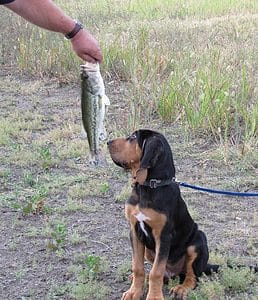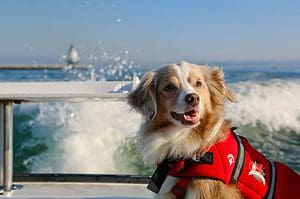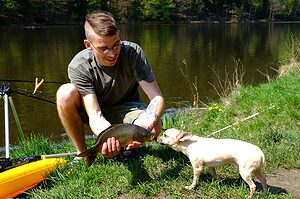Disclosure: Some posts contain affiliate links, which earn us a commission if you make a purchase through them. Positive Fishing © participates in various affiliate networks including the Amazon Services LLC Associates Program.
It’s no easy task to find a fishing partner that’s always willing to be on your schedule. Dogs, however, don’t care if you’re late or staying on the water until dusk.
I always welcome meeting a dog on the trail or the boat ramp. Any time anyone or anything is happy to see me is a win in my book!
In this article, I will cover the following:
- Can I Take My Dog Fishing?
- Why Do Fisheries And Angling Clubs Ban Dogs?
- How to Train your Dog for Fishing
- Taking A Dog With You When Boat Fishing
- Taking A Dog With You When Fishing On Land
- What Are The Best Dog Breeds To Take Fishing With You?
- Tips & Tricks When Fishing With Your Dog!
- Final Thoughts
Can I Take My Dog Fishing?
In the world today, many people have dogs and want to bring them along on their adventures. If a dog is properly trained, bringing a dog fishing can be a great time! It gets them out of the house and gives them exercise and entertainment throughout the day.
Why Do Fisheries And Angling Clubs Ban Dogs?
Across the United States and the UK, many fishing areas do not allow dogs. The reason behind the dog ban when fishing is due to the number of incidents that have created issues with the public or other wildlife. These areas include public places as well as private fisheries or commercial fisheries.
Most private fisheries, including lakes and rivers, ban dogs, which will be part of the rules of the local state area, angling club, or the fishing syndicate.
You are almost certainly not allowed to take your dog when you fish in competition matches. Match fishermen tend to take fishing a little more seriously than pleasure anglers, so there is no point even asking, “can I bring my dog fishing?”
However, many places allow dogs to be taken whilst fishing, but you will need to explore and read the rules on where you plan to go fishing.
How To Train Your Dog To Go Fishing With You

Dogs aren’t always going to be natural on the water. Just like you had to train yourself how to fish, you have to do the same with dogs. Be diligent in how you train them because it will lead to a great fishing trip with your dog and you going forwards.
Training your dog to go fishing requires daily interaction and frequently going to the river or the lake.
Show Your Dog Your Fishing Equipment
Familiarity is vital for dogs. If they don’t know what something is, they will be naturally curious at potentially the wrong times.
So, before you ever hit the water, please show them your rod, line, net, and tackle box. Take all your fishing gear out into the yard or back garden and simulate fishing. If your dog is already well-trained, you can warn them of getting too close to specific fishing tackle items.
I’ve seen dogs crash into the water when an owner throws in a lure. Dogs love playing fetch, and their owner just threw something into the water, so why wouldn’t they try and grab it?
This scenario can be a scary sight! The last thing you want is for your dog to get hooked. The vet bills and trauma from the incident would be enough never to take your dog fishing again. By warning your dog of the dangers of hooks and fishing equipment, they’ll be less likely to want to go after your equipment and make any dangerous movements.
If you plan to take your dog on a boat fishing, let your dog climb around on your boat at home and familiarize itself with it. Teach it to sit down or lay down on the boat, so it can bring the movements it usually does indoors or on land to the boat.
Lastly, always show the dog where it can sit or lie and do your best to teach it before you ever hit the water properly. A dog knowing its position on the boat to sit can be crucial to a successful fishing trip with your dog.
First Take Them On An Easy Outdoor Adventure
If many dogs had their way in the outdoors, there’d be no boundaries, and they could go and investigate anything they wanted. This investigative spirit can cause issues with other anglers and could ruin your perfect fishing spot.
By taking a dog on a hike or a walk around the lake or along the riverbank, you can give them some boundaries to work within. They will learn very fast about the water. Use the same commands you use around your house to show them how far away they can get from you and where they’re allowed to go.
Once your dog knows the boundaries it can work within; it’ll have a far better understanding of what you’re hoping to accomplish.
If you are comfortable with your dog, you can introduce them to other anglers that are fishing. Most anglers are quite used to dogs as long as they are well-behaved.
Start Fishing In Seclusion
Once you feel comfortable with your dog and its outdoor manners, you can try a local pond or a more secluded area to practice.
You don’t want your dog’s first fishing experience to be around a dozen other anglers. It can quickly turn into a disaster if you aren’t careful.
A small pond where they can see you cast and operate will teach them quite a bit. It’ll be all new things that they see their owner doing, and they’ll want to be a part of it.
You can allow them to make mistakes in these private situations that are more low-risk. It’ll be a great learning tool for them as they learn about your hobby.
Remember, hooks and lures and certain other fishing tackle can be dangerous. I know many anglers who don’t tie any bait to the end of their line when first training their dogs.
They will tie on a lead weight and cast it into the water. In case the dog goes in after it, they won’t get hurt if they happen to grab it. This allows you to teach the dog proper manners and behavior before you cast life-threatening objects out in the water.
Take Your Dog Fishing During The Weekdays
If possible, try to take your dog fishing during the weekdays. Fewer people will make this process much easier, and your dog will learn faster what to do and what not to do.
Being alone with your dog while fishing also helps you relax a little more, knowing that you or the dog are not causing any disturbances.
Introduce Them To Fish
Finally, once you feel your dog can handle itself outdoors, you must introduce them to the most exciting part of fishing: the fish!
Most dogs have one of two reactions when they see fish. Either they’re so excited that they want to take it and eat it, or they’re terrified and run away. Again, they are wild animals, and instincts kick in when they see another wild animal flopping around.
Train your dogs to be calm around fish. They make jerky movements and can scare dogs. Start by showing them the fish in a net. Keep the fish in the water and let the dog sniff and do some investigating. Don’t let it bite the fish!
Dogs need to understand and familiarize themselves with small and large fish. In my experience, most dogs get playful and will often bark if they see a fish in the net. At this important time, you must spend time with them, letting them know what’s right and wrong when showing them your fish,
Over time your dog will get more comfortable or lose interest when the fish is in the net, then you can take the fish out of the net and show it to them closer. After a few sniffs, they will likely wag their tail.
Many anglers take their fish out of the water to snap a picture, and that’s okay! However, you don’t want your dog to take a swipe at it and potentially injure it in the process. It is best to take pictures once your dog has been fishing with you several times.
If you want more details on training your dog professionally, check out this great group of articles from Orvis.
Taking A Dog With You When Boat Fishing

Things get a bit hectic when you’re ready to hit the lake or river. You’re backing up to the boat launch, getting gear ready, and doing it all at a faster pace. The last thing you want is a rogue dog that makes the entire process even more stressful.
If you are out on the sea with your dog whilst fishing, it can be even more concerning if you are not prepared.
Keep The Dog Contained
Unless you’re absolutely positive about your dog’s patience and behavior, please keep it in the vehicle until you’re ready actually to get on the boat.
Once you’re ready, hook it onto a leash and walk it down the boat. Once you do this a few times, dogs will become familiar with the process! At first, they’ll be on high alert. There may be people, other dogs, and moving cars. Keep it close as it’s learning the ropes.
Other fishermen can get stressed about preparing as well! You don’t want dogs to get in their fishing equipment or cause unnecessary distractions.
Teach It To Stay In The Boat!
Depending on your dog, it may love water! If it does, that’s great. However, you don’t want it to go jumping off as you’re moving along or anchored at a spot. It can cause them serious harm and ruin a perfectly good fishing location.
As you’re letting your dog wander around on the boat while it’s on land, be sure not to let it jump off whenever it wants. Either hook it up to a leash or give it specific commands when it can jump.
Get A Dog Personal Floatation Device
Like humans, most dogs can swim. However, many of us prefer to wear a life jacket when out on a boat. Strong currents or rough weather can happen at any time. So having some canine lifejacket for your dog is a sensible idea.
While dogs can be strong swimmers, you don’t want anything drastic to happen. Purchase a dog life jacket, teach the dog to wear it, and you’ll rest assured that if something does happen, it’ll be safe.
PFD for dogs are not expensive and well worth the investment to protect your dog when fishing.
Taking A Dog With You When Fishing On Land
Every land angler can recall a story of an unruly dog causing trouble while fishing. It’s hard to be polite in these situations! Some anglers are not dog lovers and don’t appreciate dogs’ intrusion near their fishing spots.
Know Your Surroundings
If you’re fishing along a riverbank in a more secluded area, don’t let your dog run free. You don’t always know what’s around the next bend and don’t want to come around and find it interacting with an angry angler.
Keep it leashed, or have some shock collar that will keep it close to you. Don’t let them wander around!
Best Dog Breeds To Take Fishing With You?
Some dog breeds will always be better fishing companions than others. Most hunting dogs fall into the category of good fishing dogs as they are used to being outdoors. Patient and obedient dog breeds are the best to bring with you when going fishing, such as:
- Retrievers
- Labradors
- Spaniels
- Malamute
Dogs with intelligence and a calmer nature tend to be the best fishing partners.
Tips & Tricks When Fishing With Your Dog!

You’re going to have to stay patient with your dog. They’ll be excited that they’re outdoors and with you. If you throw fishing into the scenario, it’s entirely new and exciting for them to experience.
Dogs will make mistakes while they understand fishing etiquette, which is okay. Do your best to let them make those mistakes in low-risk situations and even better when you are at a fishing location on your own.
Dogs may like to have something familiar with them whilst out fishing, so take their favorite blanket or small basket for them to sit in whilst you are out fishing together. This will help keep them contented and happier.
Always reward your dog when it does the right thing when you are fishing. A box of dog treats only given when they do well is key in the training phase.
Make sure you always take food for them if you are out on a long day fishing. A hungry dog is going to be unhappy and not follow instructions.
Whether you are going on a short or long fishing day out with your dog, it is very important that you take plenty of fresh water for them to drink. Dogs get thirsty quickly, and you need the dog to be calm, not hot and bothered while fishing with you.
Lastly, you may find that your dog isn’t a good dog to take fishing. If that’s the case, don’t force the issue! Cut your losses and conclude that you may have to leave your dog at home most of the time you go fishing or have someone else take care of it on the river or lake.
Make sure that your dog has had all the necessary vaccinations before taking them fishing.
And finally, ensure that you take the “poo bags” and the necessary clean-up equipment with you and dispose of them in the designated dog waste bin.
Final Thoughts
Once you and your dog are trained and fully prepared to go fishing, it will be a wonderful experience. Make sure you take time at home with your dog to do the simulated fishing trips. This will make the process much easier when you both set off fishing.
I hope that this article was informative and helped you get a better understanding on how to take your dog fishing with you. Check out more articles on fishing tips and beginner’s.
- Wading Belt Essentials: Ensuring Safer Fishing - January 9, 2024
- Fishing For Catfish (Top Tips, Bait, & Gear To Catch The Big 3) - October 20, 2022
- Fishing Line Strength Vs. Diameter Chart: Why Is It Important? - October 12, 2022

